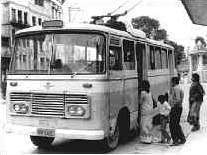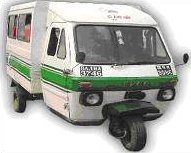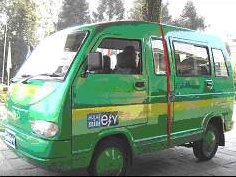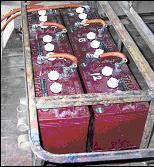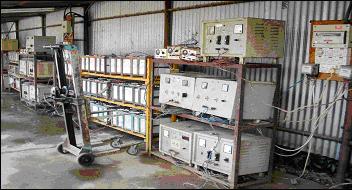Tiempo Climate Cyberlibrary
Electric Vehicles in Nepal
- Tiempo archive
- Complete issues
- Selected articles
- Cartoons
- Climate treaty
- Latest news
- Secretariat
- National reports
- IPCC
About the Cyberlibrary
The Tiempo Climate Cyberlibrary was developed by Mick Kelly and Sarah Granich on behalf of the Stockholm Environment Institute and the International Institute for Environment and Development, with sponsorship from the Swedish International Development Cooperation Agency.
While every effort is made to ensure that information on this site, and on other sites that are referenced here, is accurate, no liability for loss or damage resulting from use of this information can be accepted.
 |
Megesh Tiwari discusses the development of the use of electric vehicles in Nepal and current initiatives that are expanding their use across the transport sector. |
|
The author is a research officer with Winrock International, Nepal. |
|
Modern civilization is based on an economy that depends heavily on an adequate supply of energy. There has been a huge reliance on fossil fuels to meet the energy needs for the industrial, household and transport sectors throughout world society. These resources are, however, limited and global discussions have begun on how long they will last and what alternatives are feasible.
According to the United States Energy Information Administration, the world demand for oil in 2005 averaged 83.7 million barrels per day. The forecast for consumption through 2006 is 85.3 million barrels per day and for 2007 it is 87.2 million barrels per day. Between 2003 and 2005, there was a 2.22 per cent growth in the demand for oil. If this growth rate persists then efforts to meet the increasing demand will, apparently, cause worldwide oil reserves to be drained by 2028. We are very close to depleting global oil reserves on the supply side and will be increasingly prone to harsh economic pressures on the demand side.
Historically, Nepal has imported all of its petroleum products and relies almost entirely on fossil fuels for transportation. This sector depends heavily on imported oil from India. Oil prices increase every year with the result that the Nepalese government has to continue, and has even had to increase, the amount of subsidy being provided. Cross-border price differences have also given rise to the smuggling of cheap oil from Nepal to India. These factors, amongst others, have resulted in a drain on the foreign reserves of the country which come from hard-earned public revenues. This, in turn, causes Nepal to become poorer by the day.
It is high time we utilize fully the possibilities in energy alternatives so we can survive the tremendous economic threat inherent in the impending oil crisis.
The transport sector is the largest consumer of petroleum products in Nepal and is also a major economic driver. This is a significant incentive for Nepal to be more electricity oriented in meeting its energy needs. Hydro resources in Nepal have the capacity to generate 42,000MW of electricity. In view of this, it is obvious that hydroelectricity is the best alternative energy source that can meet the energy demands of the transport sector. A massive increase in the electrification of the transport system can be achieved through the utilization of Nepal's hydroelectricity potential.
Most hydropower plants in the country are of the run of the river type and have a low grid load factor (that is, low efficiency of use) with a huge chunk of electricity going to waste during off peak hours (night time). There are major possibilities for using this unused electricity to charge batteries that can be used to operate battery-powered electric vehicles during the day time.
There is, in fact, a long history of transport powered by electricity in Nepal. In the 1960s, the first electric ropeway was installed to transport goods from Hetauda in the south to Kathmandu. A ropeway is a rope or cable-based transport system used in mountainous areas. The ropeway system consists of steel cables connected to poles with passenger/goods-carrying gondolas sliding along the cable. This traction system can be powered either manually or by a motor.
In 1975, the government of the People's Republic of China installed the first electric vehicles used for public transportation in Nepal, a 13km-long electric trolley bus system with 22 buses to start with. In 1997, ten more buses were granted by the Chinese government to meet the increasing passenger demand. These electric trolley buses provided an excellent and dependable service to commuters.
Though the electric trolley bus system has been running for the past 30 years, a lack of proper maintenance and management is now ruining this once highly-accredited service. Most of the buses have been grounded, primarily through a lack of available spare parts. The service has been reduced to a 5km-route, with only three buses at present.
|
|
Electric trolley bus in Kathmandu © KEVA |
Organizations such as the Kathmandu Electric Vehicle Alliance (KEVA) and Winrock International, Nepal, have offered assistance in the areas of technology, business development, awareness raising and policy advocacy to revive the ailing electric trolley system. But what the trolley bus requires at the moment, to rehabilitate the system, is a competent management structure to operate under an innovative business plan that maximizes investments. The electric trolley bus system could reclaim its popularity if operated under a public-private partnership. Initiatives are ongoing to develop such a partnership, thereby recreating a successful electric trolley bus-based public transport system in Kathmandu.
The development of battery-operated electric vehicles started in 1993 when the United States-based Global Resources Institute, with funding from the United States-Asia Environmental Partnership, the National Association of State Development Agencies and USAID/Nepal, started the work of converting commonly-available diesel three-wheelers into battery-operated three wheelers.
Commercial manufacturing of battery-operated electric three-wheelers, commonly known today as 'Safa Tempos', began in 1996 when a private company called the Nepal Electric Vehicle Company was established. Production of Safa Tempos boomed after the government decided to ban the ultra-polluting diesel-operated three-wheelers from the Kathmandu valley. Most of these polluting three-wheelers were converted into Safa Tempos.
A decade later, the number of Safa Tempos running in the streets of Kathmandu has exceeded 600 and the number of these vehicles is continually increasing. Whilst most of these Safa Tempos operate within the public transportation sector in Kathmandu, many also operate as office vehicles, maintenance vehicles, tourism vehicles and waste collection vehicles. Safa Tempos are also being used widely in Nepal by ministries, diplomatic organizations, donor organizations, municipalities, media organizations and public and private organizations.
Most Safa Tempos are used to ferry commuters within the Kathmandu Valley. Each Safa Tempo travels a distance of 100 to 120kms each day on two sets of batteries. A battery set contains twelve six-volt deep cycle lead acid batteries with a full charge capacity of 185 ampere hours. These batteries on full charge show 77 to 79 volts, then discharged to 72 volts during operation. After the first set of batteries has completed 50 to 60kms, the Safa Tempos return to the charging stations where the other battery set is loaded onto the vehicles for an additional 50 to 60kms of operation.
Through this system, Safa Tempos have been providing a cheap and dependable form of transportation to the people of Kathmandu. On average, 100,000 passengers travel by Safa Tempos every day. For its size of city, Kathmandu most probably uses the largest fleet of electric vehicles for public transportation in terms of the ratio of electric to fossil-fueled public transport vehicles. Four new Safa Tempos with enhanced features are currently being manufactured to meet the tourism industry's need for clean transportation.
|
|
A typical Safa Tempo © KEVA |
With the demand for electric vehicles obviously growing as an alternative to fossil-fuel driven vehicles, the private sector's interest in manufacturing second-generation electric vehicles with an alternating current drive system and four wheels, instead of three, is also expanding.
Recently, five REVA electric cars were imported from India into the country through private organizations. REVA is an electric car company based in Bangalore, India, and is the only car from India to have received European Union certification.
Hulas Motors, the only automobile manufacturer in Nepal, came out with its first five to ten passenger electric van on March 23rd of this year. This model is the electric version of the regular model, the Mini V, manufactured by the company. This electric vehicle is owned by and is being used as an office vehicle by Winrock International, Nepal. Other local electric vehicle manufacturers are also working on four wheel and alternating current drive-based electric vehicles.
Hulas Motors will soon enter into commercial production with the vehicle, running under the name of Mini EV. The four-wheeled vehicle will be a five to ten passenger van that can be used for private as well as public transportation.
|
|
Hulas Electric Mini V © KEVA |
The vehicle is based on an 84 volt system and uses fourteen pieces of six volt lead acid batteries. It uses an alternating current drive system and has the added features of on-board charging, regenerative braking and a multi-gear system, amongst other facilities. It is competitively priced alongside the company's regular models and it is bound to find markets for use in public and private transportation, as office vehicles, school vehicles, hospital vehicles, and in many other sectors of society. Vans are a popular mode of public and mass transportation in Nepal, which should ensure that the Hulas Mini electric vehicle grabs a significant share of this market.
Prospects for Nepal in sustainably developing its own electric vehicle industry have been strengthened in that Nepal's closest neighbours, China and India, have made a lot of progress in the development of electric vehicles.
Electric two-wheelers are already in commercial use in some cities in China. China is working for the cleanest and greenest Olympics ever in 2008 with the use of a large number of electric vehicles in Beijing. A wide variety of electric vehicles ranging from electric scooters, cars and vans to high-capacity electric buses and hybrid buses are being manufactured in China. Tinajin Qinyuan Electric Vehicle Company in China has developed a five-door mini-car called the 'Happy Messenger' that looks just like any gasoline car fit for city driving. Bus companies such as the Shanghai Sunwin Bus Corporation are manufacturing battery-operated electric buses and trolley buses.
In India, alongside REVA, Scooters India Ltd has developed several models of electric three-wheelers. Bajaj Auto Ltd is about to commercialize the electric version, 'EcoRick', of its popular three-wheelers in the near future. Bigger companies like TATA and Ashok Leyland are working to manufacture trolley buses and other electric vehicles. BHEL, a public sector company, has made electric buses.
|
Electric vehicles and the tourist industry In March 2006, the Kathmandu Environmental Education Project completed a report on "Promoting Electric Vehicles in Tourism Industry" (4.2mb download). Based on a wide-ranging survey, the results clearly indicate that electric vehicles as a means of transportation throughout the tourist industry would be very well received, not only by tourists but also by hotel and travel entrepreneurs. There was overwhelming agreement that the use of such vehicles would greatly enhance the air quality in Kathmandu. Tourists consider air pollution as a major problem in Kathmandu and 59 per cent reckoned vehicular emission a major source of air pollution. Some considered that bad road network conditions and solid waste added to the problem. Sixty-nine per cent rated the air quality of Kathmandu as poor, while tourists who have been to Nepal on more than one occasion (29 per cent) stated that the air quality has declined as compared to their last visit. The majority of tourism entrepreneurs, 70 per cent, considered air quality in Kathmandu to be poor. They also stated that 45 per cent of tourists who come to Nepal for the first time consider air quality to be good. However, this asssessment changed drastically after a city tour or a longer period of stay in Kathmandu valley. They also mentioned that in some instances tourists have shortened their stay in Kathmandu because of pollution. When asked if they would use electric vehicles if they were available, 93.7 per cent of tourists questioned answered that they would and 79 per cent said they were prepared to pay higher fares for this service. Many respondents also pointed out that electric vehicle routes from the airport to the city and also to cultural sites would be very welcome. The local tourist industry showed a considerable degree of awareness of the potential for electric vehicles. Ninety-seven per cent thought that the use of such an environmentally-friendly product would be extremely effective because the majority of tourists would choose an eco-friendly option when it is offered. The majority of respondents suggested that the Safa Tempos could be modified in their comfort and services so they would be even more attractive to tourists and that the widespread availability of electric vehicles for transportation in the tourist industry could be made into an important and effective advertising feature. Finally, respondents claimed that there is a dire need for the government to implement strict and strong control measures to curb pollution, covering rules and regulation, the road network, transportation system and solid waste. |
Most electric vehicles in Nepal use lead acid deep cycle batteries to power the motors. The most popularly used battery is the Trojan 125 which is manufactured in the United States. The Nepalese electric vehicle industry has found Trojan batteries to be consistent and reliable in performance. A local battery manufacturer also manufactures lead acid batteries. Even though the company manufactures both flat and cylindrical plate batteries, these have not found popularity due to their relatively poor performance.
According to a survey conducted by KEVA, the average life of Trojan 125 batteries, used by the Safa Tempos, was found to be 20 months or 550 deep cycles. Most batteries are watered with de-ionized water rather than distilled water. Three different brands of de-ionized water with electrical conductivities ranging from 0.2 to 1.3 are being used.
|
|
Trojan 125 deep cycle lead acid batteries © KEVA |
More than 35 battery charging stations have been established in Kathmandu to cater to the battery charging needs of Safa Tempos. On average, each charging station has 22 battery chargers. There is a mix of manual and automatic chargers in most of these charging stations. All of these chargers are manufactured locally by different companies and all chargers follow a constant current, constant voltage and constant current charging profile. The charging starts with 22 amperes and ends with two to three amperes. The battery voltage rises from 72 to 90 volts during this time. On an average, 15kWh of energy is consumed in this process. It takes 10 to 12 hours for one set of batteries to get fully charged.
|
|
Battery charging station in Kathmandu © KEVA |
In order to further promote the use of electric vehicles in Nepal, the government has reduced the customs duty on electric vehicle chassis imports by half. The excise duty for electric vehicles has also been waived. Very minimal custom duties in the order of one to five per cent have been applied for major electric vehicle accessories such as motors, controllers, batteries and so on. The batteries used for electric vehicles have also been exempted from Value Added Tax.
All these government incentives have encouraged private sector investment. These steps have established a secure and encouraging environment for foreign investors wanting to manufacture electric vehicles as a means to exporting to the huge markets in India and China. As a result, Nepal is witnessing a boom in the development and use of electric vehicles and there is no doubt that many more electric vehicles will be added to the fleet in coming years.
Disclaimer
The views expressed in this article are those of the author
and do not explicitly represent those of the author's
affiliated organization.
Further information
Megesh Tiwari, Clean Energy Group, Winrock International,
Nepal, PO Box 1312 Kathmandu, Nepal. Fax: +977-1-4476109.
Email: mtiwari@winrock.org.np.
Web: www.winrock.org.np/cleanenergygroup.php.
On the Web
Nepal's Initial National Communication under the UNFCCC
is available as a 2.8Mb
download. The Tiempo Climate Cyberlibrary presents a
listing of theme sites on mountains and climate
change.
Bright Ideas

General Electric plans to cut solar installation costs by half

Project 90 by 2030 supports South African school children and managers reduce their carbon footprint through its Club programme

Bath & North East Somerset Council in the United Kingdom has installed smart LED carriageway lighting that automatically adjusts to light and traffic levels

The United States National Oceanic and Atmospheric Administration and the American Public Gardens Association are mounting an educational exhibit at Longwood Gardens showing the link between temperature and planting zones

The energy-efficient Crowne Plaza Copenhagen Towers hotel is powered by renewable and sustainable sources, including integrated solar photovoltaics and guest-powered bicycles
El Hierro, one of the Canary Islands, plans to generate 80 per cent of its energy from renewable sources

The green roof on the Remarkables Primary School in New Zealand reduces stormwater runoff, provides insulation and doubles as an outdoor classroom

The Weather Info for All project aims to roll out up to five thousand automatic weather observation stations throughout Africa

SolSource turns its own waste heat into electricity or stores it in thermal fabrics, harnessing the sun's energy for cooking and electricity for low-income families

The Wave House uses vegetation for its architectural and environmental qualities, and especially in terms of thermal insulation

The Mbale compost-processing plant in Uganda produces cheaper fertilizer and reduces greenhouse gas emissions

At Casa Grande, Frito-Lay has reduced energy consumption by nearly a fifth since 2006 by, amongst other things, installing a heat recovery system to preheat cooking oil
Updated: May 15th 2015
